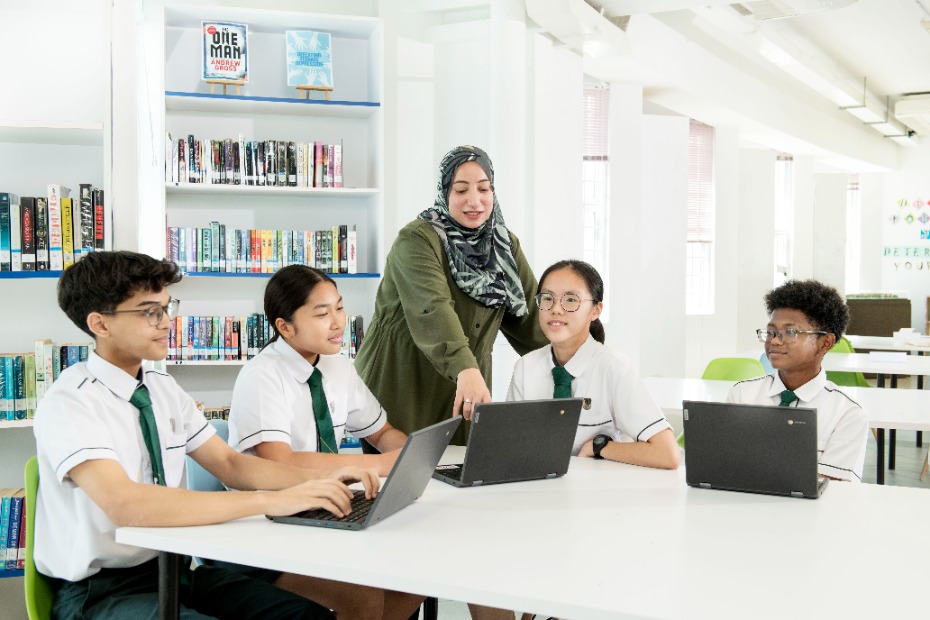What inspires you to teach?
When I was studying in polytechnic and university, I met Nursimah, who is now a fellow educator and a close friend. She was the brightest student in class. Though we were busy with our studies, she never shied away from sharing her knowledge, even with those who were not in the same project groups. She tutored us and shared all (and I mean ALL) her notes.
She still came up top as a valedictorian and even made it to the dean’s list in university. She taught me that one will never lose out no matter how much we give of ourselves.
Becoming a teacher is my way of giving. My fellow teachers and I try to give our students a sense of belonging, to develop a supportive and thriving culture where everyone feels valued and included, and is encouraged to be the best version of themselves. Being in St. Gabriel’s, I am grateful to my mentors and colleagues who are always supportive and nurturing, which further inspires me to do the same for my students.
.jpg)
In every form class that I teach, I put up a class quote – “Character 1st, Academics a Close 2nd” – on the notice board where everyone can see it. Why? Because character guides one’s actions. Through the lesson packages and activities I design for CCE, for example, students form conclusions on what is “expected” or “socially acceptable” behaviour, and develop a sense of integrity and moral courage. I strive to support my students’ growth in character, as they become better versions of themselves every day, regardless of whether it takes days, weeks, months, or years.
With my students, school life often revolves around playing sports. The basketball court, where many of them hang around between breaks or gather to bond, is where you can find me when I have pockets of time, to get to know them as individuals and be available to chat about anything. I like to say I’m “shooting hoops” with them, though everyone knows I can’t play basketball to save my life!
Describe a teaching approach you have found effective.
“Are You Smarter Than Ms Nisa?”. “1E2 vs Ms Nisa”. “Homework or No Homework?”.
Mini “competitions” work well to motivate my students and keep them engaged and on task. It also gels with the boy-centric education approach we take in St Gabriel’s, where lessons centre around discussion, movement, challenges and routines.
“It is about finding the best way to engage each class.”
Ms Khairunnisa Bte Ismail
Seeding an element of competition into their learning has worked well for my Food and Consumer Education class. The lessons already naturally incorporate pair work and hands-on practice, but by layering on a “Most Instagrammable Dish” competition element, my students took their work more seriously and were extra motivated to plate their dishes beautifully.
Of course, competition is not everything – the aim is not to pit my students against each other all the time. It is about finding the best way to engage each class.
Different cohorts and classes learn best in different ways, and I adapt my lessons accordingly. For example, when I taught History students about the Maria Hertogh riot, I planned a debate on who was responsible for the riot, for the class that enjoyed sharing their opinions. For the class that preferred games and movement, we did a role play before discussing who should be responsible. For yet another class that required more visual aids to process information, I showed them videos and newspaper articles on the different parties involved in the riot, before moving on to guided worksheets and class discussions.
Through experimenting with different types of lessons, I get to receive a wide range of feedback from my students, which enables me to reflect on how I can better facilitate and support my students’ learning.
Which school initiative are you especially proud of?
My rapport with my students allows me to build relationships with them and help them beyond their academic needs.
A few years ago, I had a class that generally had lower motivation and discipline. They struggled to complete their homework in a timely manner because they either genuinely forgot, lacked the discipline and drive, or just found the work too difficult.
I decided to hold these students back after school to ensure that they completed their homework for their different subjects. It turned into a weekly after-school session – some call it a study group, or a homework club; there is no official name for it.
Once the students are on track, they are released from the group. Interestingly, some of them chose to stay on. They found the study group to be a conducive space not only to complete their daily work, but to lend support to one another, and to pick up life skills along the way, much like a home away from home. My role is to maintain an encouraging presence, and when I’m not keeping everyone on track, I might be teaching them how to craft an email or use online tools – skills they may find useful but don’t have access to.
As homework submission rates improved, I believe that my students also strived to become more motivated and disciplined individuals. Some days, I still find it heartwarming that students look for me to have a chat or join in the study group even when I no longer teach them.



.jpg)


